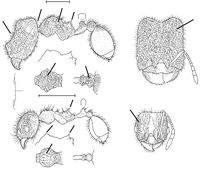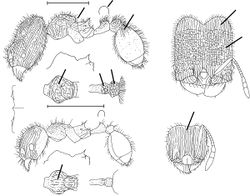Key to Pheidole distorta group
This worker key is based on: Wilson, E. O. 2003. Pheidole in the New World: A dominant, hyperdiverse ant genus. Harvard University Press, Cambridge, MA.
This group marked by the bizarre head and mesosoma of the major caste as well as the heavy rugoreticular sculpturing of both its head and mesosoma, most closely resembles the tristis group. Nowhere common, species of the distorta group range variously from Panama to Argentina
You may also be interested in
1
- Major and minor: lacking propodeal spines; instead, the basal and descending faces of the propodeum seen from the side meet to form a right or obtuse angle; the promesonotum in side view rises to form an extremely elevated hump that descends posteriorly through a face as long as the adjacent basal face of the propodeum (Colombia) . . . . . . Pheidole distorta
 Pheidole distorta, Major |
- Minor: has well-developed propodeal spine. Major (in those species where it is known) also has a well-developed propodeal spine, and the posterior face of the promesonotum is shorter than the basal face of the propodeum in side view . . . . . 2
2
return to couplet #1
- Minor: with huge propodeal spine, as long as or longer than the basal face of the propodeum anterior to it, seen from the side . . . . . 3
- Minor: with ordinary propodeal spine, shorter than the basal face of the propodeum anterior to it, seen from the side . . . . . 4
3
return to couplet #2
- Minor: occiput and pronotum rugoreticulate; anterior fourth of first gastral tergite longitudinally striate (Amazonian Brazil) . . . . . Pheidole deima
 Pheidole deima, Major |
- Minor: occiput smooth in center; pronotum carinulate, first gastral tergite foveolate but not striate (tropical South America) . . . . . Pheidole dolon
4
return to couplet #2
- Minor: dorsal surface of head posterior to frontal lobes smooth and shiny . . . . . Pheidole reclusi
 Pheidole reclusi, Major |
- Minor: most or all of dorsal surface of head posterior to frontal lobes carinulate or rugoreticulate . . . . . 5
5
return to couplet #4
- Minor: dorsal surface of head bears extensive rugoreticulation above and mesad to the eye (Argentina, Bolivia) . . . . . Pheidole scapulata
 Pheidole scapulata, Minor |
- Minor: dorsal surface of head bears only longitudinal carinulae . . . . . 6
6
return to couplet #5
- Minor: dorsal surface of head, including occiput, completely covered with longitudinal carinulae; dorsa of major petiole and postpetiole rugoreticulate (Mato Grosso, Brazil) . . . . . Pheidole monstrosa
- Minor: occiput smooth and shiny, and most of rest of dorsal surface of head bears longitudinal carinulae; dorsa of major petiole and postpetiole carinulate, not rugoreticulate (Brazil, Ecuador) . . . . . Pheidole bufo
 Pheidole bufo, Major |















